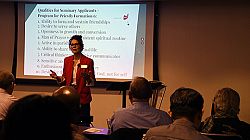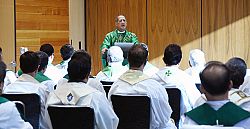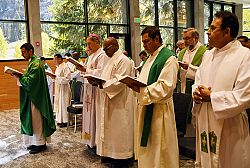Clergy convocation focuses on vocations ministry
Friday, Oct. 17, 2025

IC photo/Marie Mischel
Photo 1 of 3
Rhonda Gruenewald, founder of Vocation Ministry, addresses the priests at the convocation.
SANDY — Practical ways to foster vocations to the priesthood, religious life and sacramental marriage were the focus of the fall clergy convocation, held Oct. 6-9 at Snowbird Resort. The convocation was intended to help priests prepare for the Nov. 15 vocations promotion training that will be presented by the diocesan Office of Vocations at the behest of Bishop Oscar A. Solis.
The Diocese of Salt Lake City has 59 priests in active parish ministry now, but that number will drop to 43 in the next 15 years if there are no new vocations, said Rhonda Gruenewald, the keynote speaker at the clergy convocation.
Gruenewald is founder of Vocation Ministry, “a nationwide nonprofit dedicated to fostering a culture of vocations in parishes, schools, and families,” according to vocationministry.com. The website also reports that in the United States in the last 10 years, the numbers of priests and religious sisters have dropped by 12 percent and more than 29 percent, respectively.
However, this can change by having priests and laypeople make vocations a year-round conversation, said Gruenewald, who gave the diocesan priests several steps to follow to encourage vocations in their parishes.
“Wherever the family intersects with their faith there should be a message about vocations, and the priests have a crucial role in that,” she said; these places include at church, during religious education classes and other instruction, such as marriage preparation.
Priests should also share their own vocations story, she said, and “give an authentic, joyful witness, because a joyful priest can inspire vocations to priesthood, consecrated life, sacramental marriage. And even though they may not be joyful 24/7, I hope that if they’re talking about their own call, their own priesthood, that they can find the joy in that to share, because that is so attractive to others.”
However, they should also mention the difficulties, she said, because “every vocation includes the cross.”
Every parish should have a vocations ministry, run by laypeople, that includes activities such as a chalice box, which parishioners can take home to pray for vocations, she said.
The vocations office has given each parish and mission a chalice box as well as a prayer manual to go with it; these were available at the convocation for parishes that did not already have one.
Priests also “need to be actively inviting and accompanying those young people at their parish” who are discerning a vocation, Gruenewald said, noting that 75 percent of seminarians were inspired by a priest they knew.
The laity can help their pastors “get the soil fertile for the Holy Spirit to plant seeds” for vocations through prayer, awareness and education, and affirmation of young people discerning vocations, Gruenewald said.
These steps have paid off in other dioceses, she said. For example, the Archdiocese of Hartford had only one seminarian enter each year for about 10 years, she said, but after they implemented the Vocations Ministry steps in 2024 they had five new seminarians the first year, 11 this year and are planning for 20 next year.
“So, the fruit can come,” she said.
Father Carlos Guzman, RCJ, director of the diocesan Office of Vocations and administrator of Saint Anne Parish in Salt Lake City, said Gruenewald’s presentation was an “eye-opener” in terms of the landscape of vocations in the U.S.
The training was timely because the clergy now has a better way of understanding the scarcity of vocations in the diocese; it also offered a way to take action to become vocation promoters, he said.
Fr. Guzman made his own presentation at the convocation, during which he urged his fellow priests to help the laity of their parish make a priority of vocations.
“Everyone is a vocations promoter,” he said.
He also asked the priests to help young people who might be interested in a vocation “discover the voice of the one who calls,” he said.
In addition to the chalice box, parishes should have at least one Holy Hour for vocations each month, he said, which would become “a way by which the community is gathered together in prayer.”
Bishop Solis, in his comments, said it is important for priests to pray for vocations and to work to encourage them.
“There is a gold mine in this diocese” of vocations, the bishop said, but before that treasure can be enjoyed they have “to dig the soil together so that the fertile soil of Utah will bring forth the richness of vocations to the priesthood and religious life.”
He said he hoped that in five years the diocese will have at least 12 new seminarians. “It will happen by the grace of God and with your help,” he added.
Father Christopher Gray, rector of the Cathedral of the Madeleine, said that some time ago he had seen Vocation Ministry’s report on the data of the decline of the number of seminarians and priests in the U.S., “and it was terrifying.”
However, “I am beside myself with happiness that we asked this group to come to present to us” at the convocation because Vocation Ministry has presented their program to more than 70 dioceses, “and in those dioceses there has been a marked increase – 2x, 3x – of seminarians year over year following the practices that are laid out,” Fr. Gray said, adding that he is excited about the direction the diocese is going in “being intentional about our work with vocations.”
For questions, comments or to report inaccuracies on the website, please CLICK HERE.
© Copyright 2025 The Diocese of Salt Lake City. All rights reserved.
© Copyright 2025 The Diocese of Salt Lake City. All rights reserved.



Stay Connected With Us